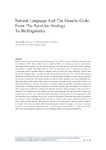Mostrar o rexistro simple do ítem
Natural language and the genetic code: from the semiotic analogy to biolinguistics
| dc.contributor.author | Bel Enguix, Gemma | es_ES |
| dc.contributor.author | Jiménez López, M. Dolores | es_ES |
| dc.date.accessioned | 2014-10-02T12:31:39Z | |
| dc.date.available | 2014-10-02T12:31:39Z | |
| dc.date.issued | 2012 | es_ES |
| dc.identifier.citation | Culture of communication / Communication of culture, 2012: 771-780. ISBN: 978-84-9749-522-6 | es_ES |
| dc.identifier.isbn | 978-84-9749-522-6 | es_ES |
| dc.identifier.uri | http://hdl.handle.net/2183/13378 | |
| dc.description.abstract | [Abstract] With the discovery of the DNA structure (Watson and Crick, 1953), the idea of DNA as a linguistic code arose (Monod, 1970). Many researchers have considered DNA as a language, pointing out the semiotic parallelism between genetic code and natural language. This idea had been discussed, almost dismissed and somehow accepted. This paper does not claim that the genetic code is a linguistic structure, but it highlights several important semiotic analogies between DNA and verbal language. Genetic code and natural language share a number of units, structures and operations. The syntactic and semantic parallelisms between those codes should lead to a methodological exchange between biology, linguistics and semiotics. During the 20th century, biology has become a pilot science, so that many disciplines have formulated their theories under models taken from biology. Computer science has become almost a bioinspired field thanks to the great development of natural computing and DNA computing. Biology and semiotics are two different sciences challenged by the same common goal of deciphering the codes of the nature. Linguistics could become another «bio-inspired» science by taking advantage of the structural and «semantic» similarities between the genetic code and natural language. Biological methods coming from computer science can be very useful in the field of linguistics, since they provide flexible and intuitive tools for describing natural languages. In this way, we obtain a theoretical framework where biology, linguistics and computer science exchange methods and interact, thanks to the semiotic parallelism between the genetic code a natural language. The influence of the semiotics of the genetic code in linguistics is parallel to the need of achieving an implementable formal description of natural language. In this paper we present an overview of different bio-inspired methods — from theoretical computer science — that during the last years have been successfully applied to several linguistics issues, from syntax to pragmatics. | es_ES |
| dc.language.iso | eng | es_ES |
| dc.publisher | Universidade da Coruña | es_ES |
| dc.title | Natural language and the genetic code: from the semiotic analogy to biolinguistics | es_ES |
| dc.type | info:eu-repo/semantics/conferenceObject | es_ES |
| dc.rights.access | info:eu-repo/semantics/openAccess | es_ES |






